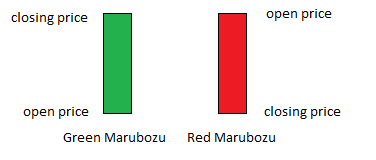MARUBOZU CANDLESTICK
MARUBOZU CANDLE
The Marubozu candlestick
pattern is a one-candle, easy-to-spot signal with a very clear meaning. It
comes in both a bearish (red or black) and a bullish (green or white) form, and
it commands attention with its long and sturdy shape. To learn more about how Marubozu
candlesticks form, why they form, and what they can tell you about the current
state of the market.
Formation
It
doesn’t get any simpler than this! Even the Doji,
that tiny little sprite, isn’t easier to spot than the Marubozu.
If you think you’ve found a Marubozu
candlestick pattern, look for the following criteria:
First, the
single candle involved in the signal should have a long real body. Second, there
must not be an upper or a lower wick (a.k.a., a shadow).
That’s
all there is to it! You’re looking for a big block
without any extraneous limbs or extensions.
The
signal can be white/green or black/red, and it can appear anywhere on the
chart. A white/green Marubozu
moves upward and is very bullish, and a black/red Marubozu
moves downward and is very bearish. The longer the candle is, the more dramatic
the jump in price has been (whether it jumped up or down).
Sometimes
you will see these signals called simply White Marubozu
and Black Marubozu.
Meaning
The
word marubozu means
“bald head” or “shaved head” in Japanese, and this is reflected in the
candlestick’s lack of wicks. When you see a Marubozu
candlestick, the fact that there are no wicks tells you that the session
opened at the high price of the day and closed at the low price of the
day. In a bullish Marubozu, the
buyers maintained control of the price throughout the day, from the opening
bell to the close. In a bearish Marubozu,
the sellers controlled the price from the opening bell to the close.
Depending
on where a Marubozu is
located and what color it is, you can make predictions:
If a
White Marubozu
occurs at the end of an uptrend, a continuation is likely.
If a
White Marubozu
occurs at the end of a downtrend, a reversal is likely.
If a
Black Marubozu
occurs at the end of a downtrend, a continuation is likely.
If a
Black Marubozu
occurs at the end of an uptrend, a reversal is likely.
However,
because these conjectures fail to provide 100% certainty, it is always
best to confirm your suspicions by watching the candles that appear after the Marubozu.
If the next few candles confirm your forecast (or if you spot another
supportive candlestick pattern), feel free to move forward with confidence.


Comments
Post a Comment